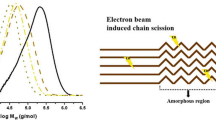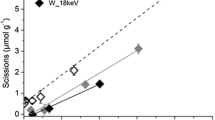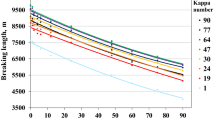Abstract
There is presently a concern because the US Postal Service now has 8 electron beam accelerators to treat mail in locations along the east coast and that a sufficient dosage to destroy Anthrax is also strong enough to darken and weaken the paper in the postal envelopes. In addition to direct photolytic scission of the cellulose chain, irradiation darkens paper, swells pulp fibres, increases hygroscopicity, and renders the cellulose more soluble in alkaline solution and more susceptible to acid hydrolysis. This report will focus on the effect of electron beam irradiation on degradation of cellulose of fine papers. Three reference papers were selected, sorted into postal envelopes and exposed to electron beam irradiation. The results have shown that irradiation at the dosage used to treat mail by the US Postal Service depolymerizes and oxidizes the cellulose. Depolymerization is responsible for a decrease of paper strength while oxidation induces darkening of the paper. Irradiating at high electron beam energy is less damaging than using lower energy. Moreover, linear relationships have been found between the number of chain scission (CSN) in cellulose and the irradiation dosage as well as between CSN and Zero-Span Breaking Length. These relationships make the strength loss predictable.
Similar content being viewed by others
References
Bouchard J., Méthot M., Lapierre L. and Berry R. (2004). Combined effect of polysulphide pulping and ECF bleaching on softwood polysaccharides. J. Pulp Paper Sci. 30(6):172–176
Charlesby A. (1960). Atomic Radiation and Polymers. Pergamon Press, London, pp. 361
Charlesby A. (1955). The degradation of cellulose by ionizing radiation. J. Polymer Sci. XV:263–270
Desai R.L. (1968). Photodegradation of cellulosic materials – a review of the literature. Pulp Paper Mag. Can. 69(16):53–61
Ducháček V. and Blud’ovsky R. (1979). Gamma irradiation of cellulose and some problems of its utilization. Radiochem. Radioanal. Lett. 38(1):31–38
Dziedziela W.M. and Rosiak J. (1977). Some aspects of radiation-induced transformations of cellulose. Cell. Chem. Technol. 11:261–268
Ershov B.G. and Klimentov A.S. (1977). Nature of the radicals and the mechanism of low-temperature of radiolysis of cellulose. Vysokomol. Soed. 19a(4):808–812
Ershov B.G., Matiushkina E.P. and Samuilova S.D. (1984). Radiation-Chemical destruction of cellulose. ZfI-Mitt 97:325–332
Fardim P. and Holmbom B. (2003). Fast determination of anionic groups in different pulp fibers by methylene blue sorption. Tappi J. 2(10):28–32
Gurnagul N., Page D.H. and Paice M.G. (1992) The effect of cellulose degradation on the strength of wood pulp fibres. Nordic Pulp Pap. Res. J. 7(3):152–154
Iller E., Kukiełka A., Stupińska H. and Mikołajczyc M. (2002). Electron-beam stimulation of the reactivity of cellulose pulps for production of derivatives. Radiation Phys. Chem. 63:253–257
Kenaga D.L. and Cowling E.B. 1959. Effect of gamma radiation on ponderosa pine: hygroscopicity, swelling, and decay susceptibility. For. Prod. J. 9:112–116
Lapierre L. and Bouchard J. (1999). Molecular weight determination of softwood kraft cellulose: effects of carbanilation solvent, hemicelluloses, and lignin. In: Argyropoulos D.S. (eds). Advances in Lignocellulosics Characterization. Tappi Press, Atlanta, pp. 239–262
McLaren K.G. (1978). Degradation of cellulose in irradiated wood and purified celluloses. Int. J. Appl. Radiation Isotopes 29:631–635
Morin F.G., Jordan B.D. and Marchessault R.H. (2004). High-energy radiation-induced changes in the crystal morphology of cellulose. Macromolecules 37(7):2268–2270
Muto N., Takahashi K. and Yamazaki H. (1995). Effect of electron beam irradiation on characteristics of paper. Japan Tappi J. 49(7):1086–1097
Nitzel K. (1984). The influence of electron beam processing on the degradation of cellulose. J. Indust. Irradiation Tech. 2(1):11–30
Paton J.M. and Hearmon R.F.S. 1957. Effect of exposure to gamma-rays on the hygroscopicity of sitka spruce wood. Nature 179: 651
Potter J.E. (2002). U. S. Postal Service emergency preparedness plan for protecting postal employees and postal customers from exposure to biohazard material and for ensuring mail security against bioterror attacks. U.S. Postal Service, Washington D. C
Pruzinec J., Kadlecik J., Varga S. and Pivovarnicek F. (1981). Study on the effect of high-energy radiation on cellulose. Radiochem. Radioanal. Lett. 49:395–397
Saeman J.F., Millet M.A. and Lawton E.J. (1952). Effect of high-energy cathode rays on cellulose. Industrial Eng. Chem. 44(12):2848–2852
Tabács E., Wojnárovits L., Földváry C., Hargittai P., Borsa J. and Sajó I. (2000). Effect of combined gamma-irradiation and alkali treatment on cotton cellulose. Radiation Phys. Chem. 57:399–403
Winogradoff N.N. 1950. X-ray irradiation of cellulose acetate. Nature 165: 72
Acknowledgements
The authors would like to thank Dr L. Lapierre for discussion regarding polymer structure in solvent and J. Wang for carbonyl and carboxyl analyses. A special thank to Dr D. Gray and Dr R. Berry for their critical reviews of the manuscript.
Author information
Authors and Affiliations
Corresponding author
Appendices
Appendix
Appendix 2: Solvated structure of irradiated cellulose carbanilates
When cellulose is degraded by processes involving homolytic radical reactions, there is always the possibility of formation of few cellulose–cellulose bonds or cellulose cross-linking. When we determined the degree of polymerization distribution of the carbanilated pulp samples by SEC/MALLS, we also get information about the volume occupied by the polymer in the solvent. Effectively, the light scattering signal allows the calculation of the Root Mean Square Radius (RMS Radius). The RMS varies linearly with the weight-average DP and a straight line is obtained from the plot of RMS vs DPW.
The slope of this line provides information about the solvated structure of the polymer. A lower slope value implies a more packed structure:
-
Slope of 1: polymer is solvated in the form of a cylinder or rigid rod
-
Slope of 0.5: polymer is solvated in the form of a random coil
-
Slope of 0.33: polymer is solvated in the form of a sphere
In the case of pure carbanilated cellulose, the RMS/DPW slope value is around 0.55–0.60 which means a random coil structure in THF. When we plotted the RMS/DPW slope data of all our samples as a function of dosage as shown in Figure 8, the following observations can be made:
-
All the series irradiated using high energy electron beam (10 MeV) follow the same trend: a slow decrease of the RMS/DPW ratio from 0.58 down to 0.50
-
In the case of the 2 series (SW and CO) irradiated at lower electron beam energy (4.5 MeV) there is a drastic decrease of the RMS/DPW ratio down to 0.3–0.4. This change implies that instead of being solvated in a random coil structure, the samples treated at dosage above 100 kGy are now solvated in THF in the form of a packed sphere once carbanilated.
As in the case of the cellulose chain scission, the lower electron beam energy seems to cause more drastic change at the same irradiation dosage. For the series treated at 10 MeV, the increase in carbonyl content in pulp can account for a small decrease in the yield of carbanilation and explain that structure of the carbanilated cellulose solubilized in THF may change slightly.
However, for both series treated at 4.5 MeV (SW and CO), the drastic solvated structure change when dissolved in THF cannot be related to significant chemical differences with samples from the 10 MeV series at a specific DPW: the samples have the same carboxyl and carbonyl content. Two possible explanations can account for that difference:
-
Other unknown types of chemical degradation are happening at 4.5 MeV and are responsible for a non-ideal carbanilation of the pulp and a consequent non-ideal solubilization in THF.
-
Cross-linking reactions may be present and lead to carbanilated structures which have a different solvated structure in THF.
Appendix 3: Trend of molecular weight distribution with irradiation
The MWD of irradiated cellulose ought to tend toward the exponential distribution. If a random event such as a radioactive decay has a constant likelihood of occurrence, then the number of events in a given duration will correspond to a Poisson distribution and the intervals between successive events will correspond to an exponential distribution. Thus, if electrons uniformly bombard an infinitely long cellulose chain, the number of bombardments per millimetre will correspond to the Poisson distribution, and the segment length between bombardment locations will be exponentially distributed. If the cellulose cleaves exactly at each bombardment location, then the MWD of the cleavage fragments will be exponential. Although natural cellulose exhibits finite DP, the initial MWD will largely influence the high end of the MWD of cellulose cleaved by radiolysis, and the distribution will progressively approach exponential form at higher irradiation dosages. Charlesby (1955) assumed as much in his theory.
However, the molecular weight distributions measured are not exponential (e −bx) but follow more closely to a gamma distribution (x d e −bx). The exponential parameter “b” increases as expected with irradiation dose, in keeping with the molecular shortening. The exponent “d” varies much less with irradiation dose. Where the shortest cleavage segments should be most numerous according to the exponential distribution, we observe a near vanishing of the shortest segments.
This implies that the molecule cannot be cleaving precisely at the bombardment site. Alternatively, cleavages that are closer together may spontaneously heal before they can be oxidized and rendered permanent.
Ershov et al. (1984) has shown that cotton cellulose irradiated at elevated temperature suffered more scissions per unit of irradiation dosage. The scission rate corresponded to an Arrhenius activation energy of 4 kcal/mol which they associated with crowding oxidizing ions into the scission site to tie-off the new chain ends. One may speculate that the energetics favour more separation between oxidation sites. In any case, the minimum chain length reduces at higher irradiation dosages, so oxidation sites do get closer as the number of bombardment sites proliferate.
The observation that the MWD is more like a gamma distribution than an exponential distribution brings into question Charlesby’s predictions regarding the evolution of DP during irradiation to the extent that his theory supposes an exponential MWD.
Rights and permissions
About this article
Cite this article
Bouchard, J., Méthot, M. & Jordan, B. The effects of ionizing radiation on the cellulose of woodfree paper. Cellulose 13, 601–610 (2006). https://doi.org/10.1007/s10570-005-9033-0
Received:
Accepted:
Published:
Issue Date:
DOI: https://doi.org/10.1007/s10570-005-9033-0





